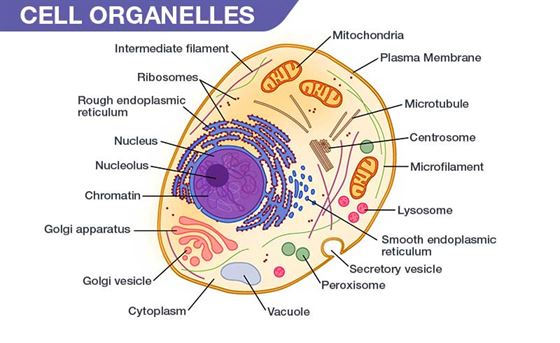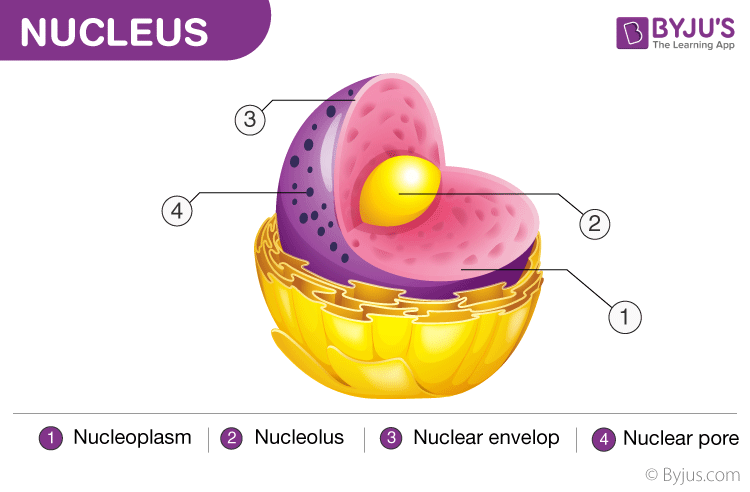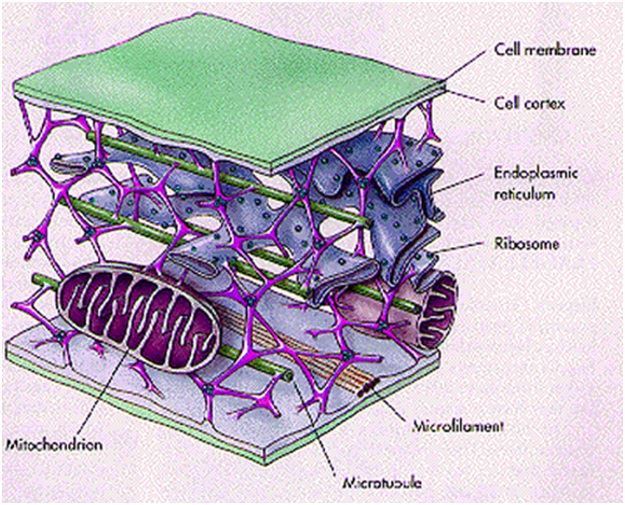The cellular components are called the Cell Organelles. These cell organelles are membrane-bound, present within the cells and are distinct in their structures and functions. They coordinate with their functions efficiently for the normal functioning of the cell. Few of them functions providing shape and support, whereas some are involved in the locomotion and reproduction of a cell. There are various organelles present within the cell and are classified into three categories based on the presence or absence of membrane.
Organelles without membrane: The Cell wall, Ribosomes, and Cytoskeleton are membrane-bound cell organelles. They are present both in prokaryotic cell and the eukaryotic cell.
Single membrane-bound organelles: Vacuole, Lysosome, Golgi Apparatus, Endoplasmic Reticulum are single membrane-bound organelles present only in a eukaryotic cell.
Double membrane-bound organelles: Mitochondria and chloroplast are double membrane-bound organelles present only in a eukaryotic cell.
Plasma Membrane
The plasma membrane is also termed as a Cell Membrane or Cytoplasmic Membrane. It is a selectively permeable membrane of the cell, which is composed of a lipid bilayer and proteins.
The plasma membrane is present both in plant and animal cell, which functions as the selectively permeable membrane, by permitting the entry of selective materials in and out of the cell according to the requirement. In an animal cell, the cell membrane functions by providing shape and protects the inner contents of the cell. Based on the structure of the plasma membrane, it is regarded as the fluid mosaic model. According to the fluid mosaic model, the plasma membrane are subcellular structures, made of a lipid bilayer in which the protein molecules are embedded.
FLUID MOSAIC MODEL OF PLASMA MEMBRANE
Cytoplasm
The cytoplasm is present both in plant and animal cells. They are jelly-like substances, found between the cell membrane and nucleus. They are mainly composed of water, organic and inorganic compounds. The cytoplasm is one of the essential components of the cell, where all the cell organelles are embedded. These cell organelles contain enzymes, mainly responsible for controlling all metabolic activity taking place within the cell and are the site for most of the chemical reactions within a cell.
Nucleus
The nucleus is a double-membraned organelle found in all eukaryotic cells. It is the largest organelle, which functions as the control centre of the cellular activities and is the storehouse of the cell’s DNA. By structure, the nucleus is dark, round, surrounded by a nuclear membrane. It is a porous membrane (like cell membrane) and forms a wall between cytoplasm and nucleus. Within the nucleus, there are tiny spherical bodies called nucleolus. It also carries another essential structure, called chromosomes.
Chromosomes are thin and thread-like structures which carry another important structure called a gene. Genes are a hereditary unit in organisms i.e., it helps in the inheritance of traits from one generation (parents) to another (offspring). Hence, the nucleus controls the characters and functions of cells in our body. The primary function of the nucleus is to monitor cellular activities including metabolism and growth by making use of DNA’s genetic information. Nucleoli in the nucleus are responsible for the synthesis of protein and RNA.

Endoplasmic Reticulum
The Endoplasmic Reticulum is a network of membranous canals filled with fluid. They are the transport system of the cell, involved in transporting materials throughout the cell.
There are two different types of Endoplasmic Reticulum:
- Rough Endoplasmic Reticulum – They are composed of cisternae, tubules, and vesicles, which are found throughout the cell and are involved with protein manufacture.
- Smooth Endoplasmic Reticulum – They are the storage organelle, associated with the production of lipids, steroids, and also responsible for detoxifying the cell.
Mitochondria
Mitochondria are called as the powerhouses of the cell as they produce energy-rich molecules for the cell. The mitochondrial genome is inherited maternally in several organisms. It is a double membrane-bound, sausage-shaped organelle, found in almost all eukaryotic cells.
The double membranes divide its lumen into two distinct aqueous compartments. The inner compartment is called ‘matrix’ which is folded into cristae whereas the outer membrane forms a continuous boundary with the cytoplasm. They usually vary in their size and are found either round or oval in shape. Mitochondria are the sites of aerobic respiration in the cell, produces energy in the form of ATP and helps in the transformation of the molecules.

Plastids
Plastids are large membrane-bound organelles which contain pigments. Based on the type of pigments, plastids are of three types:
- Chloroplasts – Chloroplasts are double membrane-bound organelles, which usually vary in their shape – from a disc shape to spherical, discoid, oval and ribbon. They are present in mesophyll cells of leaves, which store chloroplasts and other carotenoid pigments. These pigments are responsible for trapping light energy for photosynthesis. The inner membrane encloses a space called the stroma. Flattened disc-like chlorophyll-containing structures known as thylakoids are arranged in a stacked manner like a pile of coins. Each pile is called as granum (plural: grana) and the thylakoids of different grana are connected by flat membranous tubules known as stromal lamella. Just like the mitochondrial matrix, the stroma of chloroplast also contains a double-stranded circular DNA, 70S ribosomes, and enzymes which required for the synthesis of carbohydrates and proteins.
- Chromoplasts – The chromoplasts include fat-soluble, carotenoid pigments like xanthophylls, carotene, etc. which provide the plants with their characteristic color – yellow, orange, red, etc.
- Leucoplasts – Leucoplasts are colorless plastids which store nutrients. Amyloplasts store carbohydrates (like starch in potatoes), aleuroplasts store proteins, and elaioplasts store oils and fats.
Ribosomes
Ribosomes are nonmembrane-bound and important cytoplasmic organelles found in close association with the endoplasmic reticulum. Ribosomes are found in the form of tiny particles in a large number of cells and are mainly composed of 2/3rd of RNA and 1/3rd of protein. They are named as the 70s (found in prokaryotes) or 80s (found in eukaryotes) The letter S refers to the density and the size, known as Svedberg’s Unit. Both 70S and 80S ribosomes are composed of two sub-units. Ribosomes are either encompassed within the endoplasmic reticulum or are freely traced in the cell’s cytoplasm. Ribosomal RNA and Ribosomal proteins are the two components that together constitute ribosomes. The primary function of the ribosomes includes protein synthesis in all living cells that ensure the survival of the cell.
ribosome subunits
Golgi Apparatus
It is a continuous network of filamentous proteinaceous structures that run throughout the cytoplasm, from the nucleus to the plasma membrane. It is found in all living cells, notably in the eukaryotes. The cytoskeleton matrix is composed of different types of proteins that can divide rapidly or disassemble depending on the requirement of the cells.Golgi Apparatus also termed as Golgi Complex. It is a membrane-bound organelle, which is mainly composed of a series of flattened, stacked pouches called cisternae. This cell organelle is primarily responsible for transporting, modifying, and packaging proteins and lipid to targeted destinations. Golgi Apparatus is found within the cytoplasm of a cell and are present in both plant and animal cells.
Cytoskeleton
The cytoskeleton is the network of fibres forming the eukaryotic cells, prokaryotic cells and archaeans. These fibres in the eukaryotic cells contain a complex mesh of protein filaments and motor proteins that help in cell movement.

Microtubules
Microtubules appear like small, hollow, round tubes with a diameter of about 24 nanometers. They are made up of a protein, tubulin. Thirteen tubulins link to form a single tube. Microtubules are very dynamic structures, which reveal that they can change quickly. They keep growing or shrinking steadily. These help in transporting cellular materials and dividing chromosomes during cell division.
Microfilaments
Microfilaments are thread-like protein fibres, 3-6 nm in diameter. They are particularly found in muscle cells. They consist of the protein actin, responsible for muscle contraction. These are also responsible for cellular movements including cytokinesis, contraction, and gliding.

No comments:
Post a Comment